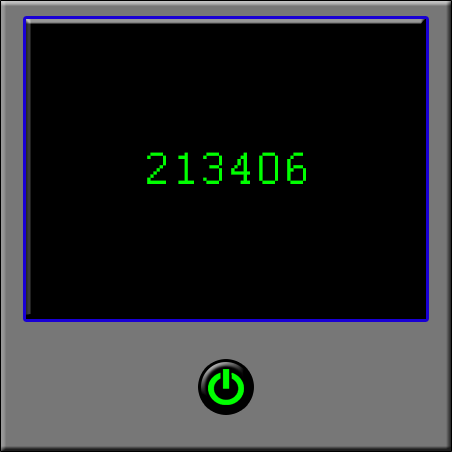Table of Contents
Secure Word Count Program
Let's suppose that you are designing a word count program for paranoid users who don't trust their computer's word count program, the shell, and even the kernel to manage processing their secret data. But they trust you, so you must design a secure word count program based on the customer's configuration.
Customer Configuration:
- White Box Desktop x86 (32-bit)
- Intel Core i3-4160 3 MiB L3 Cache 3.6 GHz
- 4 GiB dual channel DDR3 SDRAM 1600 MHz
- 1 TB Hard drive SATA 7200 rpm
- Intel HD Integrated Graphics
- Disk Controller
When the user presses the power button the computer should:
- Boot up
- Run the word count program
- Display the word count on the screen
Input:
- ASCII text file less than 1 TB on disk
- Definition of word: [A-Za-z]+
Output:
- Number of words in file
The UI consists of just the power button and the screen.

So how does the booting process work?
To answer this question we take a look at the next section, Bootstrapping
Bootstrapping
The first thing the computer will do when it boots up is it will run the Basic Input/Output System (BIOS).
Where is the BIOS?
The BIOS is located in the RAM in a section known as the Electrically Erasable Programmable Read-Only Memory (EEPROM).
The BIOS is located in the RAM in a section known as the Electrically Erasable Programmable Read-Only Memory (EEPROM).
The BIOS will then do the following:
- Perform hardware self-tests
- Scan for devices
- If device has MBR (identified by the signature 0xAA55) it is bootable
- Loads MBR into RAM at 0x7c00 and the instruction pointer jumps to 0x7c00
RAM (Random Access Memory)


Master Boot Record Layout (MBR)
The MBR is located on the disk which is separated into 512 byte sectors. Typically the MBR is the first sector on disk. The MBR has 3 parts as shown below:
MBR


The signature, as mentioned before, is what identifies this sector as the MBR. The partition table contains four 16-byte long sections which contain different information: the type of partition, the starting sector, the number of sectors, and flags. Usually the MBR code will load the Volume Boot Record (VBR) into the RAM, then the VBR would load the operating system, and the operating system would load different programs like our word count program. This is called chain loading.
Chain Loading
Basically chain loading is when a program is executed to execute another program. A simple example of chain loading is the
Basically chain loading is when a program is executed to execute another program. A simple example of chain loading is the
exec command:
#/bin/sh foo=bar exec sed "s/foo/$foo/g"Within the shell that's running this bash script, there will be a subshell running the
sed program.
However, since our users are paranoid we just want the MBR to load the word count program directly. Our code below uses low level I/O instructions to communicate with the device:
inb() and outb().
//MBR Code for (int i = 0; i < 80; i++) //40 KiB = 80 sectors read_ide_sector(i + 100,0x20000 + i * 512); //(sector number, memory address) goto *0x20000; void read_ide_sector(int s, int a) { //read disk sector to the RAM wait_for_ready(); outb(0x1f2, 1); //0x1f2 - number of sectors for (int i = 0; i < 4; i++) //0x1f3 to 0x1f6 - sector offsets outb(0x1f3 + i, (s >> (8 * i)) & 0xff); outb(0x1f7, 0x20); //read sectors wait_for_ready(); /* When the disk is ready to be read, the results which are stored in the disk controller's cache goes to the CPU first then gets loaded into the RAM. insl() copies 128 words (512 bytes) into RAM. */ insl(0x1f0, a, 128); } void wait_for_ready(void) { //wait until it's ready while ((inb(0x1f7) & 0xc0) != 0x40) //0x1f7 - status register continue; /* Our disk speed is: 7200 RPM ==> 120 Hz ==> 8.333 ms/rotation. The average time for the read head of the disk to move to the correct track is 10 ms. The average rotational latency is 4.166 ms. Then our average delay is around ~15 ms. */ }

//WC Program void main(void) { long long int nwords = 0; int s = 50000; bool inword = false; int len; do { char buf[513]; buf[512] = 0; //end of the buffer read_ide_sector(s++, (int)buf); len = strlen(buf); nwords += cws(buf, len, &inword); } while (len == 512); display_cws(nwords); } int cws(char *buf, int bufsize, bool *inword) { //cws - count words in sector int w = 0; for (int i = 0; i < bufsize; i++) { bool alpha = isalpha((unsigned char)buf[i]); w += alpha & !*inword; *inword = alpha; } }

void display_cws(int nwords) { //displaying on the screen char *screen = 0xB8000 + 200; do { screen[0] = (nwords % 10) + '0'; screen[1] = 7; //grey on black screen -= 2; } while (nwords /= 10 != 0); }